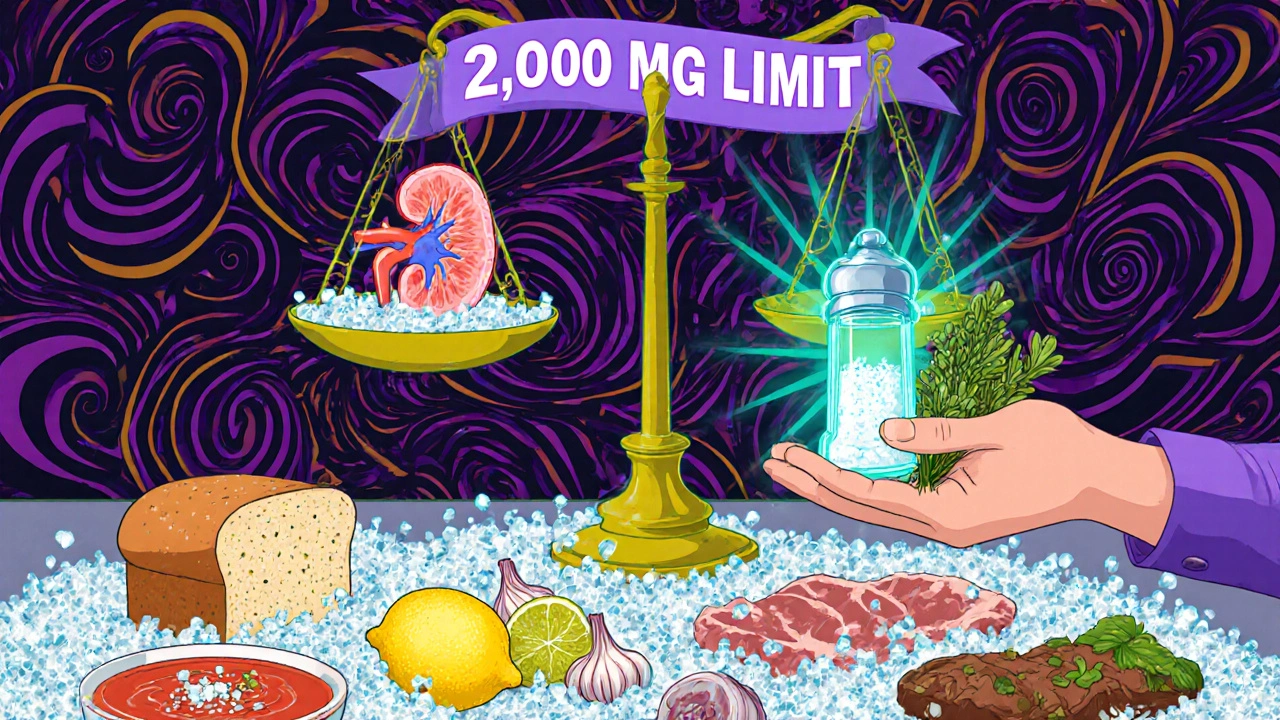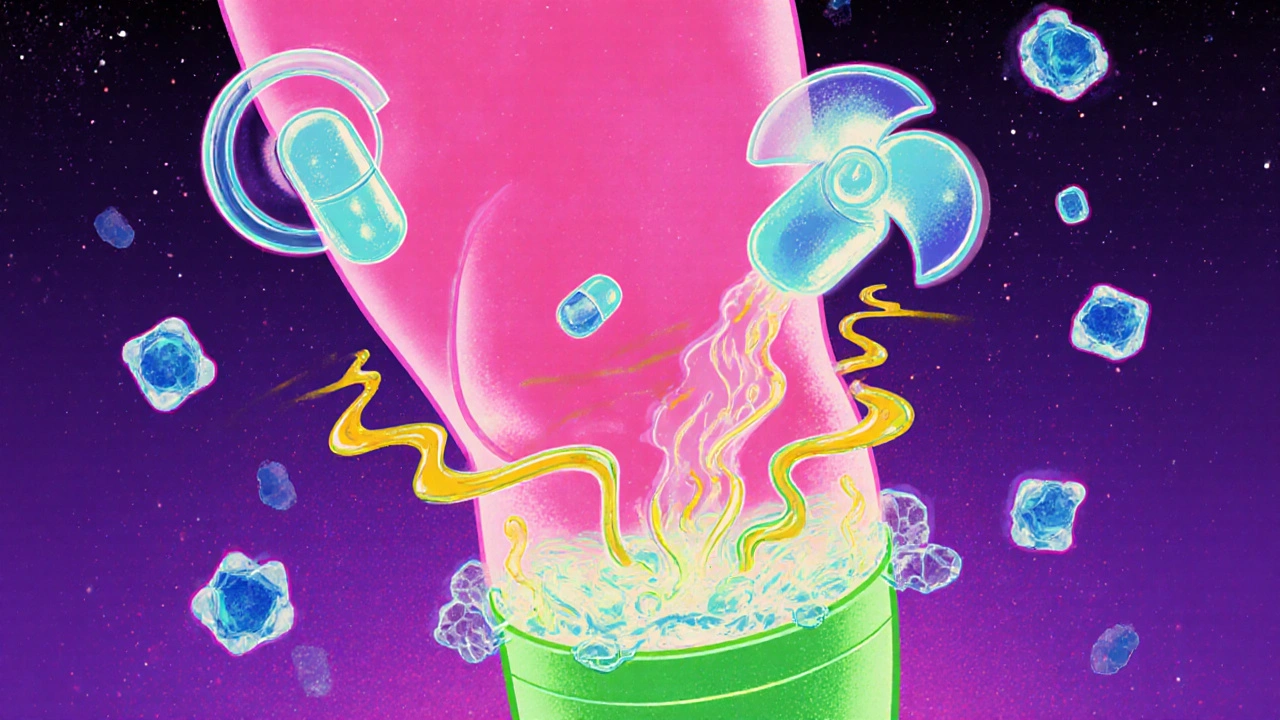Why Edema Happens in Chronic Kidney Disease
When your kidneys aren’t working well, they can’t flush out extra salt and water like they should. That’s when fluid starts piling up in your tissues-your ankles swell, your legs feel heavy, and sometimes your face or belly gets puffy. This is edema, and it’s one of the most common and uncomfortable signs of advanced chronic kidney disease (CKD), especially in stages 3 to 5.
It’s not just about drinking too much water. The real problem is sodium. Your kidneys normally keep sodium levels in check, but when kidney function drops below 60 mL/min/1.73m² (eGFR), sodium builds up in your blood. That pulls water with it, increasing pressure in your blood vessels. Fluid leaks out into your legs, feet, and even your lungs. Left unchecked, this can lead to shortness of breath, high blood pressure, and hospital visits.
Managing this isn’t about one magic fix. It’s a three-part system: controlling salt, using the right diuretics, and adding mechanical help like compression. Get one wrong, and the others struggle to work.
Diuretics: The Right Drug, at the Right Dose
Diuretics are the go-to medication for pulling fluid out of your body. But not all diuretics work the same in CKD. If your kidneys are still working okay (eGFR above 30), a thiazide like hydrochlorothiazide (12.5-25 mg daily) can help. But once kidney function drops below 30, those stop working well. That’s when loop diuretics like furosemide come in.
Doctors typically start with 40-80 mg of furosemide per day. If that doesn’t move enough fluid, they’ll bump it up by 20-40 mg every few days. In severe cases, doses can hit 160-320 mg daily. But here’s the catch: higher doses don’t always mean better results. In fact, a 2016 NIH study found that people on high-dose diuretics had a 47% higher chance of needing dialysis within a year. Why? Because too much fluid removal can crash your blood pressure and hurt your kidneys even more.
For patients with heart failure or cirrhosis along with CKD, spironolactone (25-50 mg daily) is often added. It helps block hormones that make your body hold onto sodium. But it’s risky-potassium levels can spike dangerously in advanced CKD. Regular blood tests are non-negotiable.
And now, there’s a new option: IV furosemide. In March 2025, the FDA approved it specifically for advanced CKD patients with eGFR under 15. Clinical trials showed it clears 38% more fluid than oral pills in these patients. That’s huge for people who can’t absorb pills properly or need fast relief.
Salt Restriction: The Most Powerful Tool You’re Probably Not Using
Most people think cutting the salt shaker is enough. It’s not. About 75% of the sodium you eat comes from packaged and processed foods. A single slice of bread can have 150-200 mg of sodium. Two slices? That’s already 10% of your daily limit. A cup of canned soup? 800-1,200 mg. Two ounces of deli meat? Another 500-700 mg.
The National Kidney Foundation recommends no more than 2,000 mg of sodium per day for anyone with CKD and edema. For stage 4 or 5, they suggest dropping to 1,500 mg. That’s less than a teaspoon of salt. Sounds impossible? It’s not-if you know where to look.
Start by reading labels. Look for “low sodium,” “no salt added,” or “unsalted.” Avoid anything with more than 200 mg of sodium per serving. Cook at home using herbs, lemon, garlic, and vinegar instead of salt. Skip the soy sauce, bouillon cubes, and pre-made sauces. Even yogurt, soup, and watermelon have hidden fluid and sodium.
Studies show that sticking to 2,000 mg of sodium a day can reduce swelling by 30-40% in early-stage CKD-without any pills. That’s more effective than many people realize. But it’s hard. A 2024 survey by the American Kidney Fund found that 68% of patients struggle with salt restriction. Taste, social meals, and lack of access to low-sodium foods are the biggest barriers. Working with a renal dietitian-even just 3-4 sessions-can double your success rate.

Compression and Movement: When Your Legs Just Won’t Stop Swelling
Even with perfect diet and medication, some fluid stays stuck in your legs. That’s where compression comes in. Graduated compression stockings (30-40 mmHg at the ankle) squeeze your legs just enough to push fluid back toward your heart. They don’t cure the problem, but they make it manageable.
Studies using water displacement measurements show these stockings can reduce leg volume by 15-20% after four weeks. But here’s the problem: most people stop wearing them. A 2022 study found only 38% kept using them past three months. Why? They’re tight, hard to put on, and can irritate the skin.
Don’t just wear them and sit still. Movement matters. Walking 30 minutes, five days a week, improves lymphatic drainage and reduces swelling by 22% compared to just resting. Elevating your legs above heart level for 20-30 minutes a few times a day helps too-it cuts pressure in your leg veins by 25-30%.
For severe cases, especially with nephrotic syndrome, intermittent pneumatic compression devices (IPCs) can help. These are machines that inflate and deflate around your legs in cycles, mimicking muscle movement. One study showed they reduced leg circumference 35% more than regular stockings alone. They’re not for everyone, but if your swelling won’t budge, ask your doctor.
The Real Risk: Too Much vs. Too Little
There’s a tightrope walk here. Too much fluid? You risk heart strain, breathing trouble, and hospitalization. Too little? Your kidneys get damaged, your blood pressure crashes, and you might need emergency dialysis sooner.
Dr. David Wheeler from KDIGO says the window for safe diuretic use narrows sharply when eGFR drops below 20. Doses over 160 mg of furosemide daily in stage 4 CKD increase the risk of acute kidney injury by 4.1 times. But Dr. Ronald Falk reminds us: untreated fluid overload kills. People with persistent edema have a 28% higher risk of dying than those who reach “dry weight”-the point where swelling is gone but you’re not dehydrated.
The goal isn’t to make you feel light. It’s to make you feel normal. Target weight loss? No more than 0.5-1.0 kg per day. That’s about 1-2 pounds. Faster than that, and you’re risking kidney damage.
That’s why the best outcomes come from teams: nephrologists, dietitians, and physical therapists working together. Mayo Clinic data shows 75% of patients with stage 3-4 CKD control their edema within eight weeks with multidisciplinary care. Only 45% do with standard care.

What’s Coming Next
Research is moving fast. The NIH’s FOCUS trial, ending in late 2025, is testing whether using bioimpedance spectroscopy (a painless scan that measures body fluid) to guide diuretic dosing reduces hospital visits. Early results show a 32% drop in admissions.
Vaptans-drugs that block water retention-are being studied, but a recent trial was stopped due to liver toxicity. So they’re not ready yet.
What’s clear? The future of edema management in CKD isn’t about stronger pills. It’s about smarter, slower, more personalized care. Less guesswork. More data. More support.
Practical Steps You Can Take Today
- Track your sodium intake using a free app like MyFitnessPal. Aim for under 2,000 mg daily.
- Ask your doctor if your diuretic dose is right for your eGFR. Don’t adjust it yourself.
- Get compression stockings (30-40 mmHg) from a medical supply store. Wear them daily.
- Walk 30 minutes, five days a week. Even slow walking helps.
- Elevate your legs for 20 minutes after sitting or standing for long periods.
- See a renal dietitian. Even one session can change your approach.
Edema in CKD doesn’t have to control your life. With the right mix of diet, medication, and movement, you can feel lighter, breathe easier, and stay out of the hospital.

Jennifer Stephenson
November 15, 2025 AT 09:14kanishetti anusha
November 15, 2025 AT 14:13Parv Trivedi
November 17, 2025 AT 03:52Koltin Hammer
November 17, 2025 AT 05:34Patrick Merk
November 17, 2025 AT 08:42Scott Walker
November 17, 2025 AT 19:39Vera Wayne
November 18, 2025 AT 10:50Eric Gregorich
November 18, 2025 AT 11:28Phil Best
November 18, 2025 AT 11:31Philip Rindom
November 19, 2025 AT 13:25Ashley B
November 20, 2025 AT 06:26roy bradfield
November 21, 2025 AT 13:27Connor Moizer
November 23, 2025 AT 05:44Liam Dunne
November 23, 2025 AT 15:31Jess Redfearn
November 23, 2025 AT 22:13Philip Rindom
November 25, 2025 AT 17:14Rodney Keats
November 27, 2025 AT 04:35Laura-Jade Vaughan
November 27, 2025 AT 10:23Erika Lukacs
November 27, 2025 AT 15:07Segun Kareem
November 29, 2025 AT 00:55